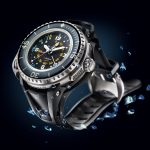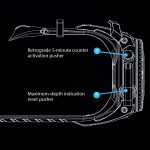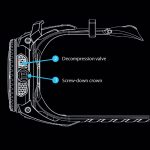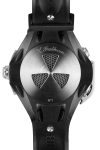Blancpain
From Fifty Fathoms to X Fathoms
Blancpain
From Fifty Fathoms to X Fathoms
The second path relates to the wars that broke out in depth-rating one-upmanship initiated by Girard-Perregaux’s Sea Hawk II Pro with its 3,000-meter rating, followed by Rolex’s Sea-Dweller DEEPSEA, which brought the depth-rating threshold to 3,900 meters; and then was usurped by the Hublot King Power Diver with its crazy 4,000-meter depth rating.
But the most interesting evolution relates to empowering the dive watch beyond its time-telling abilities. This began with a watch created in 1999 by IWC named the GST Deep One, the world’s first luxury dive watch with a mechanical depth gauge.
It should be noted that as early as 1966, Favre-Leuba had toyed with depth-gauge-equipped models named Bathy, but these watches were marketed more for their novelty value rather than as serious dive watches.
Conversely, Richard Habring, the designer of the IWC Deep One, was both incredibly serious about diving and serious about horology, having created IWC’s split-seconds chronograph mechanism as well as its tourbillon.
In 2008, Jaeger-LeCoultre created a depth-gauge watch, the Master Compressor Diving Pro Geographic that featured a largely externalized depth gauge in the form of a blackened steel membrane that would deform in a linear manner as seawater compressed it — transforming this deformation into a reading for depth from zero to 80 meters.
But while all of these watches are admirable attempts to integrate useful technology into a mechanical dive watch, none of them are capable of aiding in what is probably the most important part of a dive — the decompression stops during resurfacing.
When you dive, inert gases build up inside your body. To eliminate these gases during a dive, you need to stop at various depths — particularly critical within the last 15 meters of the dive for intervals usually regulated to five-minute periods.
These stops allow the inert gases in the form of venous microbubbles to safely depart through your lungs. Without these stops, these bubbles of inert gas can damage body tissues or even block arterial flow.
The problem with most dive watches is that they do not have a separate timing function to show these five-minute safety stops. Since the rotating bezel of a dive watch is set to show elapsed dive time, it cannot be reset to measure these intervals without compromising the overall dive timing.
Further, because dive watches with depth gauges normally display the full depth scale over a single display, it is hard to read the exact depth to the meter with a great deal of visual clarity for these stops.
Also centrally mounted on this pinion are two depth gauges, one for overall depth from zero to 90 meters, and a second all-important meter that uses a full 270 degrees to display the final zero to 15 meters critical for correct decompression.
The watch also has a third depth-gauge hand mounted co-axially with the other two to show the maximum depth reached. This hand is easily reset using the pusher at eight o’clock. This pusher is protected from accidental activation by an oversized lever.
Between 10 and 11 o’clock is a retrograde five-minute counter that is easily activated even with gloved hands, using the pusher at 10 o’clock. When you reach your decompression depth, simply press this pusher to begin the countdown.
The myriad information is given further visual distinction using different-colored luminous treatments. The scale from zero to 15 meters and the depth hand for this scale are treated in blue; the scale from zero to 90 meters and the matching hand are treated in orange; the five-minute countdown and the matching indicator are rendered in a combination of blue and orange; and finally, the hour, minute and seconds, as well as the elapsed-time scale on the unidirectional bezel, are all in green.
Water enters either from the vents in the caseback — cheekily shaped as the old “no radiation” symbol on vintage Fifty Fathoms watches — or through the caseband on either side of the crown.
Water pressure deforms the membrane. This deformation is transformed using a rack-and-pinion mechanism into a depth reading that is accurate to 30cm. This is incidentally incredibly accurate, as most electronic gauges claim accuracy of no more than ±20cm.
In terms of materials innovation, the X Fathoms literally abounds with it. The bezel is in sapphire. Blancpain makes the only bezels in modern dive watches with elapsed-time markers executed in SuperLuminova, an incredibly practical feature.
The depth-gauge membrane is made from a Liquidmetal alloy, featuring an atomic structure that is not crystalline but disordered. This creates a metal with incredible elasticity as well as memory.
It has incredible resistance to permanent deformation, it is antimagnetic and it possesses high long-term stability. The fact that the membrane is less than 1mm thick and made to ±2-micron tolerances, thus allowing a very high degree of accuracy, also deserves mention.
Finally, the rack-and-pinion mechanism that controls the rise and fall of both depth-gauge hands is made by LIGA, a combination of photolithography and galvanic plating using nickel phosphorus.
In the same way that the original 1953 Fifty Fathoms created the fundamental blueprint of all dive watches that followed, the X Fathoms is an all-new chapter in the history of the mechanical dive watch, one where finally, a mechanical timepiece features all the timing aids, visual clarity, reliability and robustness needed in contemporary diving.
And like the original Fifty Fathoms, the X Fathoms is a product of the imagination of an avid diver — Marc Hayek, the CEO of Blancpain — who has therefore not just written the latest chapter in the evolution of the Fifty Fathoms, but also the most significant new chapter in the history of the modern dive watch.


















